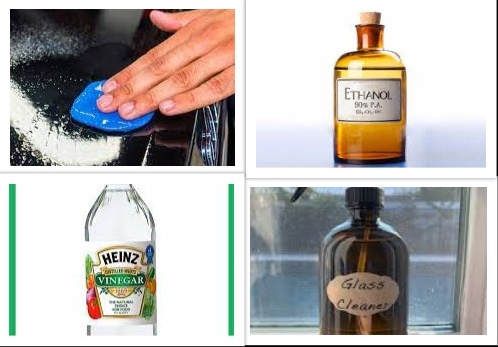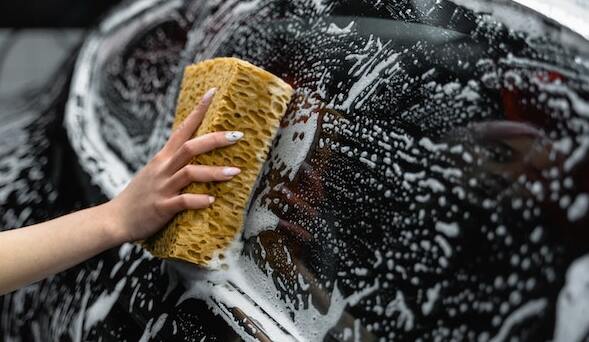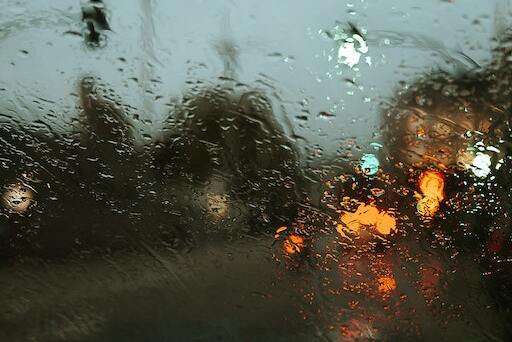It’s not uncommon to notice a film on windshield after car wash. This film can be frustrating, as it can impair your visibility and make it difficult to see while driving. In this article, we’ll explore the causes of this film and provide some tips on how to remove it.
Causes of Film on Windshield After Car Wash
There are several reasons why you might notice a film on windshield after car wash. One of the most common causes is the use of low-quality car wash soap. Some car wash soaps contain ingredients that can leave a residue on your windshield, which can create a film.
Another common cause of film on your windshield after car wash is hard water. Hard water contains minerals that can leave deposits on your windshield, which can create a film. If you live in an area with hard water, you may notice this film more frequently.
Finally, if you don’t rinse your car thoroughly after a car wash, soap residue can be left on your windshield, which can create a film.
Other Causes of Haze or Film on Windshield
There are many other causes of film or haze on windshield. Lets explore!
Smoking
It’s plausible that smoking could be the culprit, a habit known for its notorious difficulty to break. Eliminating harmful substances like smoke residue is crucial, especially from car windshields, as over time, they can create a persistent haze or film that becomes increasingly challenging to remove.
Coolant of Heater or Engine
Occasionally, leaks in your engine or heater water can result in a peculiar phenomenon—a vivid green or other colored haze that manifests on your windscreen. This hazy intrusion predominantly finds its way through the front vents, leaving behind a distinctive aroma and imbuing your windscreen with a greenish or even an entirely different hue.
To keep dangerous poisons from getting into the air, leaks must be fixed right away.
Water Spotting
Small beaded droplets of water often linger on the windshield after it air dries following a wash. The minerals in the water evaporate but get left behind, leaving dusty deposits on the glass that cause fogging and streaks.
Oils and Greases
Windshields inevitably collect oils and greases from the engine, road grime, and other automotive fluids. If these contaminants aren’t fully removed by the car wash chemicals, they can leave behind a residue on the windshield.
Silicates
Many commercial car wash formulas contain compounds like sodium metasilicate. While effective cleaning agents, silicates can bond to the glass and cause buildup over time when not properly rinsed.
How to Remove Film on Windshield After Car Wash

If you notice a film on your windshield after a car wash, there are several methods you can use to remove it. Here are a few options:
1. Vinegar Solution: Mix equal parts water and vinegar in a spray bottle. Spray the solution onto your windshield and let it sit for a few minutes. Then, use a clean microfiber cloth to wipe away the film.
2. Rubbing Alcohol: Apply rubbing alcohol to a clean microfiber cloth and wipe your windshield. This can help remove any residue that is causing the film.
3. Glass Cleaner: Use a high-quality glass cleaner and a clean microfiber cloth to wipe your windshield. This can help remove any residue that is causing the film.
4. Clay Bar: A clay bar can be used to remove any contaminants that are stuck to your windshield. Wet the clay bar and gently rub it over your windshield. This can help remove any residue that is causing the film.
Preventing Film on Windshield After Car Wash
To prevent film on your windshield after a car wash, there are a few things you can do.
- Use a high-quality car wash soap that is designed to rinse clean.
- Rinse your car thoroughly after a car wash to ensure that all soap residue is removed.
- Consider using a water softener if you live in an area with hard water.
- Apply Water Repellent Glass Coating
Wash at Reputable Facilities
Look for car washes that filter and soften their water supply and utilize high-quality soaps and techniques. Touchless, soft-cloth, and hand washes tend to perform better than harsh mechanical systems.
Dry the Windshield
Allow time for the windshield to fully air dry after the rinse cycle rather than driving away mid-drip. You can also use a squeegee, microfiber cloth, or chamois to remove excess water before it evaporates.
Clean Headlights and Wipers
Soils on your headlights and wiper blades can get smeared onto a freshly cleaned windshield. Keep these components clean to avoid transferring contaminants.
Apply a Windshield Treatment
Using a hydrophobic windshield treatment or sealant can cause water to bead up and sheet off the glass more effectively, preventing water spotting.
Rinse Off Residue ASAP
If you do spot any residual film after a wash, rinse it off as soon as possible before it fully dries and adheres to the glass. This will make it easier to remove.
Inspect the Next Day
Sometimes residue becomes more visible many hours after a wash once the glass is fully dry. Check the windshield the morning after and re-rinse if needed
How do you get car wash residue off windshield?

To get car wash residue off your windshield, you can use a few different methods.
1. Mix equal parts water and vinegar in a spray bottle and spray the solution onto your windshield. Let it sit for a few minutes, then wipe away the film with a clean microfiber cloth.
2. Apply rubbing alcohol to a clean microfiber cloth and wipe your windshield.
3. Use a high-quality glass cleaner and a clean microfiber cloth to wipe your windshield.
4. Use a clay bar to remove any contaminants that are stuck to your windshield.
5. Rinse your car thoroughly after a car wash to prevent soap residue from building up on your windshield.
Does a Car Wash Film Affect Other Car Windows?
While the windshield tends to exhibit the most obvious clouding and streaking after a wash, the side and rear windows can also become foggy from car wash residue. Water, soap, minerals, and grime run down the entire exterior body of a vehicle during the wash process. Resulting films and water spots can present on any of the glass surfaces.
However, windshields seem more susceptible for a few reasons:
- The windshield glass has a different curve and angle compared to other windows, causing water and cleaners to cling and evaporate differently.
- The windshield takes more exposure to the sun, which exacerbates water spotting as it dries.
- Windshield glass contains a thin laminate between two sheets of glass for safety. This can start to delaminate over time and allow more grime and deposits to seep in.
- The windshield encounters more air flow while driving. This dries the glass rapidly and blows around any lingering droplets.
- Windshield wipers smear and spread oils, greases, and residues across the surface over time.
So while you may notice the side or rear windows exhibit a bit of fogging after a wash, the windshield will typically demonstrate the most pronounced effect and be the most challenging to keep crystal clear. Be sure to clean all exterior glass surfaces thoroughly to prevent visibility issues.
Why Does Heat and Sun Worsen Windshield Film?
Two factors that can make a windshield film or haze appear significantly worse are heat and sun exposure. Sitting in direct sunlight causes the misty residue to become much more visible and problematic.
Here’s why:
Evaporation
The sun’s infrared radiation dries out any remaining moisture on the windshield at a rapid pace. As the water evaporates, it leaves behind a higher concentration of dissolved mineral deposits, greases, and soaps that were in it, worsening the smudgy appearance.
Magnification
The concave shape of the windshield glass actually magnifies and intensifies the sun’s glare. This further highlights any streaks, pits, or etchings in the glass. Small amounts of residue that were invisible suddenly become very apparent.
Refraction
As light passes through a medium like glass, it refracts and scatters based on variations in the material. Any tiny contaminants or inconsistencies in the windshield will bend and disrupt the light rays, creating distracting glare and dark spots.
Temperature
Heating up windshield glass makes it expand slightly, but not evenly. This exaggerates the optical distortions from subtle changes in thickness and composition. What may have started as micro-residues can appear as major blotches or clouds when heated.
UV Effects
Prolonged ultraviolet radiation from the sun can interact with and alter compounds in windshield contaminants over time, changing their appearance and making them more stubborn to remove.
While annoying, this magnifying effect from sunlight is temporary and only makes the film more optically noticeable. The actual amount of residue remains the same. So focus on proper washing and cleaning methods to prevent the buildup in the first place.
Is Rain Good for Removing Windshield Film After a Car Wash?
Can a light rain clear up that annoying windshield haze left over from a car wash? While it may seem counterintuitive, getting caught in a rainstorm can actually benefit your glass. Here’s why rain is surprisingly effective at minimizing window film:
- Rinsing Action – The sheer volume of water cascading over the windshield helps rinse away any loose contaminants or soap residue lingering on the surface after a wash.
- Sheeting Effect – Rainwater tends to sheet cleanly off the windshield without leaving behind spots. The glass is left cleaner once the rainwater evaporates.
- Pure Water – Unlike tap water, rainwater is naturally soft and free of minerals. This prevents new water deposits from forming on the glass.
- Acid Content – Rainwater contains trace amounts of carbon dioxide which lends it a slightly acidic pH, helping dissolve alkaline mineral residues.
- Pressure Washing – The force and velocity of raindrops falling from the sky provides a thorough pressure rinsing of the windshield.
- Cooler Temps – With cooler ambient temperatures, rain prevents windshield glass from quickly drying and deposition buildup.
While heavy rain can make visibility challenging in the moment, take advantage of lighter showers to allow nature to rinse away any leftover car wash films for a streak-free windshield! Just be sure to activate your window wipers to maximize results.
Car Wash Types and Methods to Minimize Windshield Film
Not all car washes are created equal when it comes to preventing annoying windshield fogging and residue. Here is an overview of common car wash types and methods, rated on their tendency to leave behind a film:
Touchless Automatic Car Washes
- High power spray jets blast away dirt.
- Minimizes scratches but can leave spots on glass.
- Film Tendency: Medium
Soft-Touch Automatic Car Washes
- Textured fabric or foam brushes provide gentle scrubbing.
- May still scratch paint at close proximity.
- Film Tendency: Medium-High
Self-Service Car Washes
- You control the spray wand and soap yourself.
- Allows thorough rinse and spot cleaning.
- Film Tendency: Low
In-Bay Automatic Car Washes
- Drive into an enclosed bay for a multi-step wash.
- May offer heated blow drying and tire/wheel cleaning.
- Film Tendency: Low-Medium
Hand Car Washes
- Employees hand wash the entire vehicle.
- Specialized products and thoroughness.
- Film Tendency: Very Low
Mobile Car Washing Services
- On-demand washers come to your location.
- Quality varies greatly between providers.
- Film Tendency: Medium
The most hands-on, customizable washes with purified water systems tend to leave the least amount of residue. But technique and maintenance at any car wash are also huge factors. Inspect windshield closely after any wash and immediately rinse any haziness.
Best Cleaners and Products to Minimize Windshield Film
Using specialty auto detailing products designed for glass can help minimize windshield fogging and water spots after washing your car. Here are some of the best cleaner options:
Glass Cleaner Concentrates
- Concentrated formulas dilute with water in a spray bottle.
- Contain silicones, ammonia, alcohol to repel residue.
- Brands like Invisible Glass, Sprayway.
Glass Cleaning Clays
- Gently rubbing clay bar picks up embedded grime.
- Avoid scratches by keeping surface wet with lubricant spray.
- Nanoskin, Clay Magic brands.
Ceramic Glass Coatings
- Form a hydrophobic barrier that causes water to bead up.
- Prevents buildup of minerals and contaminants.
- Lasts 6+ months. Brands like Rain-X, OPT Opti-Glass.
Glass Polishing Compounds
- Light abrasives remove etched deposits and stains.
- Polish out scratches and oxidation for clarity. Use with microfiber pad.
- Brands like Meguiar’s, Chemical Guys.
Glass Sealants
- Synthetic polymers bond to the glass for water beading.
- Help prevent water spot etching.
- Brands like Meguiar’s Glass Sealant, Turtle Wax.
The right products paired with proper washing and drying techniques can keep your windshield crystal clear after every car wash. Avoid products with added fragrances, dyes, and oils which can leave residue.
Professional Windshield Reconditioning to Remove Stubborn Film
For windshields with an extremely stubborn lingering film that resists all standard cleaning methods, professional reconditioning services may be required to restore optical clarity. This is an intensive multi-step process:
Diagnostic and Evaluation
A technician will first assess the condition of the glass and identify the probable causes of fogging whether it be etching, delamination, pitting, or simple surface contaminants.
Deep Cleaning
Next, a combination of specialized cleaners and machine polishers work to lift and dissolve bonded-on residues, oils, silicates and other compounds down to the microscopic level.
Glass Polishing
Light abrasives are used to microscopically smooth the outer glass layer, removing pits and roughness that contribute to resonance hazing and streaking while restoring transparency.
Glass Protectant
A protective glass sealant, coating, or treatment is applied to repel future contaminants and delay re-deposition.
Quality Inspection
The glass clarity and quality is checked under bright light and the sun’s glare to ensure a streak-free, optically pure view has been restored before returning the vehicle to the owner.
While labor intensive, this level of professional windshield reconditioning can restore clarity and provide a Defog-Free guarantee when you’ve run out of options for removing the most stubborn windshield film.
Conclusion
Conclusion
A light foggy film on the windshield following a car wash can be annoying but is fairly common. While not permanently damaging, it can pose a visibility hazard and distraction until remedied. This guide covers the main causes of the residue, ranging from hard water deposits to poor soap rinsing.
Keys steps are using high-quality car wash facilities, drying the glass thoroughly, and washing with specialty glass cleaners. For serious windshield hazing, a professional reconditioning service may be required to fully restore optical clarity. But by understanding what causes the windshield film and taking action to prevent it, car owners can maintain a crystal clear view following any car wash.
FAQs
How do you get foggy film off a windshield?
One option is to use a glass cleaner and a microfiber cloth to wipe your windshield. Another option is to mix equal parts water and vinegar in a spray bottle and spray the solution onto your windshield. Let it sit for a few minutes, then wipe away the film with a clean microfiber cloth. You can also use rubbing alcohol or a clay bar to remove the film.
Why does my windshield haze when wet?
One common cause is a buildup of dirt and grime on your windshield. When water hits the windshield, it can mix with this buildup and create a hazy film. Another possible cause is a worn-out wiper blade that is leaving streaks on your windshield.
Should I wash my windshield before or after a regular car wash?
It’s best to wash the windshield separately as a last step after the rest of the vehicle. This allows you to use clean water and soap directly on the glass to prevent transferring residues from the bodywork that could cause film.
